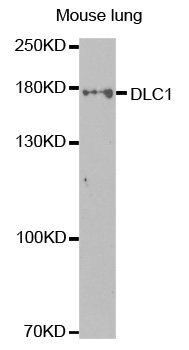Goat anti-DLC1 (Isoforms 1 and 3) Antibody
EB06436
ApplicationsImmunoFluorescence, ELISA, ImmunoHistoChemistry
Product group Antibodies
ReactivityHuman, Mouse, Porcine
TargetDLC1
Overview
- SupplierEverest Biotech
- Product NameGoat anti-DLC1 (Isoforms 1 and 3) Antibody
- Delivery Days Customer5
- Application Supplier NoteImmunofluorescence: Expression of the protein seen in the cytoplasm and nucleus of U251 and U2OS cells. Recommended concentration: 10microg/ml.
- ApplicationsImmunoFluorescence, ELISA, ImmunoHistoChemistry
- Applications SupplierPep-ELISA, IF, IHC
- CertificationResearch Use Only
- ClonalityPolyclonal
- Concentration0.5 mg/ml
- Gene ID10395
- Target nameDLC1
- Target descriptionDLC1 Rho GTPase activating protein
- Target synonymsARHGAP7, HP, STARD12, p122-RhoGAP, rho GTPase-activating protein 7, Rho-GTPase-activating protein 7, START domain-containing protein 12, StAR-related lipid transfer (START) domain containing 12, deleted in liver cancer 1 protein, epididymis secretory sperm binding protein, rho-type GTPase-activating protein 7
- HostGoat
- Scientific DescriptionRefSeq number(s): NP_872584.2; NP_079043.3. GeneIDs all Nonhuman: 50768 (mouse);. Purification: Antigen affinity purified. Names and symbols: DLC1; HP; ARHGAP7; STARD12; FLJ21120; p122-RhoGAP; deleted in liver cancer 1; Rho-GTPase-activating protein 7; START domain containing protein 12; StAR-related lipid; transfer protein 12; StAR-related lipid transfer (START) domain containing 12; deleted
- ReactivityHuman, Mouse, Porcine
- Reactivity SupplierHuman, Mouse, Pig
- Storage Instruction-20°C
- UNSPSC12352203
References
- Ko FC, Yeung YS, Wong CM, et al. Deleted in liver cancer 1 isoforms are distinctly expressed in human tissues, functionally different and under differential transcriptional regulation in hepatocellular carcinoma. Liver Int. 2010,30(1):139-48. doi: 10.1111/j.1478-3231.2009.02133.xRead this paper




